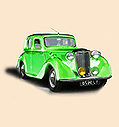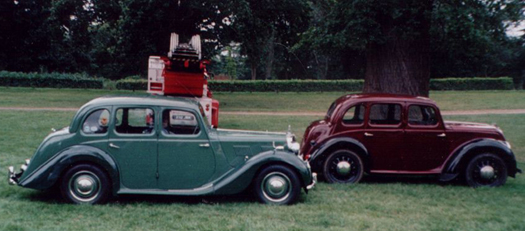|
End of Menu Items |
An unsung hero from MG
by Neil Cairns, and additional photographs by John Jebb
Download a review of the New Morris 10 here
One buys a car because it looks right and I have had my 1952 MG 'YB' for nine years now. Discovering the model's history was fascinating and it was a far more important car to MG than one would initially think. Now as one of the MG Car Club Y Register's technical odd-bods, I can reveal all.
At the 1947 Motor Show, MG had a neat little saloon displayed on its stand. This was the MG 'One and a Quarter Litre' sports saloon, 'Series Y' (later to become the YA). The flowing wing lines of the obvious late 1930s styling hinted at the fact the car had been developed prior to World War 2, and was, at last, being introduced some eight years later. This dated styling was to hold back the cars sales, even though under the skin was a very modern package of rack and pinion steering, independent front suspension, rear axle Panhard rod, a built-in Jackall system, an efficient overhead valve engine all with superb road manners.
The MG 'YA' was not a stand-alone model. Books by David Lawrence and John Lawson will tell you all about the development of the original MG 10hp in 1938-39, that led to the 'YA' being introduced after World War 2 in 1947. Due to World War 2 being declared, the 1939 Motor Show was cancelled, consequently the car was never shown. The car was designed at the Morris Design Offices in Cowley, Oxford. It was to be the third MG saloon in the range, completing the pre-war series of the VA at 12hp, and the WA at 18hp. Neither of the larger MGs was built after the war. The 'Y' Series was also part of a group of 8hp and 10hp models within the Nuffield group, and as such shared components with these other Morris and Wolseley models for obvious economic production reasons. But, unlike today where one shell will be fitted with different engines and given different badges, the managing director Len Lord permitted the cars to be quite different in some of their very basic engineering.
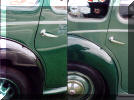 Like the MG 'TB' and' TC', the' YA' used the engine, gearbox, brakes and rear axle of the Morris Ten Series 'M'. The engine was bored out from 1140cc to 1250cc to become the XPAG, (virtually a single carburettor version of the TC engine). The gearbox gained a rearwards extension for the gear lever. The body was a slightly modified version of the monocoque tub of the Morris Eight Series 'E'. However, the Y's 'under-slung' (running under the rear axle) ladder chassis was its very own, and not used on any other model. True, it was modified at the rear to become over-slung and then used on the 1949 MG 'TD', with five inches taken out of its length. The Morris 'E' body tub was improved with a boot-bustle added at the rear, and a longer bonnet at the front, (from the Morris Ten, modified), and an upright MG grill at the front. Because the wheels of the 'Y' type were a bigger diameter than those on the series 'E', the rear doors differ between the cars where the rear wings fit. Unlike any of the other eight or ten hp Nuffield cars, the 'Y' was fitted with the then very new independent front suspension and rack and pinion steering.
Like the MG 'TB' and' TC', the' YA' used the engine, gearbox, brakes and rear axle of the Morris Ten Series 'M'. The engine was bored out from 1140cc to 1250cc to become the XPAG, (virtually a single carburettor version of the TC engine). The gearbox gained a rearwards extension for the gear lever. The body was a slightly modified version of the monocoque tub of the Morris Eight Series 'E'. However, the Y's 'under-slung' (running under the rear axle) ladder chassis was its very own, and not used on any other model. True, it was modified at the rear to become over-slung and then used on the 1949 MG 'TD', with five inches taken out of its length. The Morris 'E' body tub was improved with a boot-bustle added at the rear, and a longer bonnet at the front, (from the Morris Ten, modified), and an upright MG grill at the front. Because the wheels of the 'Y' type were a bigger diameter than those on the series 'E', the rear doors differ between the cars where the rear wings fit. Unlike any of the other eight or ten hp Nuffield cars, the 'Y' was fitted with the then very new independent front suspension and rack and pinion steering.
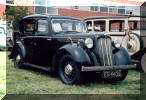
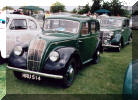 The little Morris Eight series 'E' has no chassis: two full length floor runners carried out that task, and were welded direct to the body tub. This little car used the 918cc side valve engine, a virtual copy in mirror fashion, of the Ford Eight 998cc unit, later 1172cc. It also had an alligator bonnet, then very new, whereas the 'Y' type used the normal gull-wing type. When the two cars are parked next to each other, it is obvious that they are related when the bodies are compared. However the 'Y' sits much lower on the road, due to it's under slung chassis, lower build and more sporting character. Both axles on the Morris Eight 'E' used leaf springs. The little series 'E' was built from 1939 to 1948.
The little Morris Eight series 'E' has no chassis: two full length floor runners carried out that task, and were welded direct to the body tub. This little car used the 918cc side valve engine, a virtual copy in mirror fashion, of the Ford Eight 998cc unit, later 1172cc. It also had an alligator bonnet, then very new, whereas the 'Y' type used the normal gull-wing type. When the two cars are parked next to each other, it is obvious that they are related when the bodies are compared. However the 'Y' sits much lower on the road, due to it's under slung chassis, lower build and more sporting character. Both axles on the Morris Eight 'E' used leaf springs. The little series 'E' was built from 1939 to 1948.
 The 1939 Morris Ten series 'M' was also a monocoque car with no chassis. It too used leaf sprung front and rear axles, with an anti-roll bar fitted at the front. The Morris Ten front suspension and the MG 'YA' ifs were from the drawing board of one Alex Issigonis. The 'M' sold well as its 1140cc XPJM engine revved freely, was fast and did very well on petrol. Compared to a Y the car is very stub-nosed and upright, much taller and shorter than a MG 'Y'. With its bonnet open, the similarity between the XPJM and XPAG are obvious, both use the same castings. Much of the mechanics of the series 'M' will be found in the 'TC' and 'Y'. The Morris Ten 'M' was replaced by the Morris Minor series 'MM' in 1949 (a Morris 1000 with a 918cc sv engine and split windscreen), later to be a S2, then in 1956 dubbed the Morris 1000. It is possible to get a pre-war Morris Ten 'M' and Eight series 'E' as they were being built for about 12 months till 1940.
The 1939 Morris Ten series 'M' was also a monocoque car with no chassis. It too used leaf sprung front and rear axles, with an anti-roll bar fitted at the front. The Morris Ten front suspension and the MG 'YA' ifs were from the drawing board of one Alex Issigonis. The 'M' sold well as its 1140cc XPJM engine revved freely, was fast and did very well on petrol. Compared to a Y the car is very stub-nosed and upright, much taller and shorter than a MG 'Y'. With its bonnet open, the similarity between the XPJM and XPAG are obvious, both use the same castings. Much of the mechanics of the series 'M' will be found in the 'TC' and 'Y'. The Morris Ten 'M' was replaced by the Morris Minor series 'MM' in 1949 (a Morris 1000 with a 918cc sv engine and split windscreen), later to be a S2, then in 1956 dubbed the Morris 1000. It is possible to get a pre-war Morris Ten 'M' and Eight series 'E' as they were being built for about 12 months till 1940.
The not so common next model is the Wolseley Eight and Ten versions of the equivalent Morris models. These too use a modified version of the Morris Eight series 'E' body tub, but retain the smaller boot. The Eight is a Morris Eight with a Wolseley grill fitted. On the Wolseley Ten the 'M' monocoque shell was not used, instead the modified 'E' body was mounted upon a quite solid cruciform chassis, but both still with leaf sprung axles front and rear. Note there were now three 'Ten HP' models in the Nuffield range, one chassisless Morris, one a MG on a ladder chassis, and the Wolseley on a heavy cruciform chassis. Two used the Morris Eight 'E' body tub. The Wolseley Eight uses an overhead valve version of the 918cc sv unit fitted to the Morris, and looks for all the world like a miniature XPAG. Both Wolseleys share the gearbox, rear axle and brakes of the 'Y'. Lord Nuffield (William Morris) liked the little Wolseley Eight so much, he used one as his own car. The Ten had the 1140cc ohv engine from the Morris 'M', but in this model it was called a XPJW. So if you see a Morris Eight series 'E', a Wolseley Eight or Ten S3 or a Morris Ten series 'M' stop and take a good look at them. All came from the same drawing office at Cowley as the 'YA' did.
Wolseleys were simply up-market version of Morris models, though there was never a Wolseley badged Morris Ten series 'M'.
The MG 'Y' series were themselves available in a three model range, the original four door, six light 1947 'YA', followed by an open tourer version now very rare, using the TC's engine as the 'YT' in 1949. The 'YA' was updated in 1952, getting twin-leading-shoe front brakes and a hypoid rear axle, along with improved electrics and front suspension. Fitted with smaller wheels meant the cars rear wings wheel arch were lower, and MG updated the series to become the 'YB'.
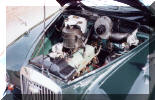 Now leaping forward to 1952, MG intended to replace the 'YB' with the new Magnette 'Z' series. This new chassis-less four door, four light sports saloon, with a very stream-lined body when compared to the upright 'Y', was to have the TD's twin carburettor XPAG engine fitted. This would probably have ended up as the 1466cc 'TF' 1500 engine as 1250cc pulling a 22cwt 'Z' along would be no sports saloon. Instead, the 'Z' gained the Austin based 1489cc BMC 'B' series engine, gearbox and rear axle and arrived in 1953. But alongside the 'Z' Magnette was a Wolseley version of the car, both designed by Gerald Palmer. It too was very sleek and a monocoque, with identical ifs and the steering rack from the 'YB'. As the Wolseley car was ready first it was available in 1952, and was sold with the MG 'YB's SC2 XPAG engine fitted, but in the Wolseley it was called a XPAW.
Now leaping forward to 1952, MG intended to replace the 'YB' with the new Magnette 'Z' series. This new chassis-less four door, four light sports saloon, with a very stream-lined body when compared to the upright 'Y', was to have the TD's twin carburettor XPAG engine fitted. This would probably have ended up as the 1466cc 'TF' 1500 engine as 1250cc pulling a 22cwt 'Z' along would be no sports saloon. Instead, the 'Z' gained the Austin based 1489cc BMC 'B' series engine, gearbox and rear axle and arrived in 1953. But alongside the 'Z' Magnette was a Wolseley version of the car, both designed by Gerald Palmer. It too was very sleek and a monocoque, with identical ifs and the steering rack from the 'YB'. As the Wolseley car was ready first it was available in 1952, and was sold with the MG 'YB's SC2 XPAG engine fitted, but in the Wolseley it was called a XPAW.
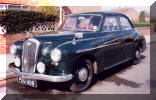
The Wolseley 4/44 as the model was called, (4 cylinder, 44bhp) had the Ys gearbox, rear axle, wheels and brakes, as well as its steering. The front suspension was unique though, only ever fitted to these Wolseleys and the ZA/ZB Magnettes. Take care, as the wheel hubs of the 4/44 only have four studs, (wheel nuts) where as the 'Y' series uses five studs. The 4/44 gearbox is the same as the YB, but it is on its side, and fitted with linkage for a column gear change. These column changes were all the rage at that time. A similar gearbox and rear axle appears on the MO series of Morris saloons, as well as the BMC Riley Pathfinder. In 1956 the 4/44 gained a single carburettor version of the ZB engine, along with the ZB brakes, rear axle and gearbox, becoming the Wolseley 15/50. The 1956 Wolseley 4/44 was the last model to use the Morris 'X' series 1250cc engine. By then the BMC derived 'A', 'B' and 'C' series ohv engines were dominant.
The little MG 'Y' series bequeathed a great deal of engineering to future BMC cars. Its rack and pinion steering could be found on Morris 1000, MO Oxford and Cowley, TD, TF, MGA, MGB, ZA, ZB, 4/44 and 15/50. The ifs fitted to the YA went on to the TD and TF, then slightly modified into the MGA and MGB lasting until 1981. An updated type was still fitted to the 1990's MG RV8. The 'Y's engine, gearbox and rear axle went into the Wolseley 4/44 and over 30,000 of these were built between 1952 and 1956. The 'Y's excellent chassis was the sole reason that the TD could be built, and that little 'T' series was the most popular ever.
No, the MG 'One and a Quarter Litre' was a milestone in MGs history. It was the first production MG to have ifs with rack and pinion steering and to be built in left hand drive form as the 'YT' a year before the 'TD' ever arrived. But today you would never suspect any of this, as for reasons not known, no one seems to know!
Additional photographs of the rear doors by John Jebb | ||||
 |
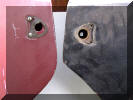 |
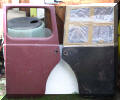 |
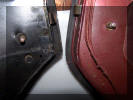 |
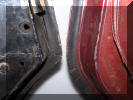 |
Rounded edge - Morris 8, Angled - MG Y | ||||
